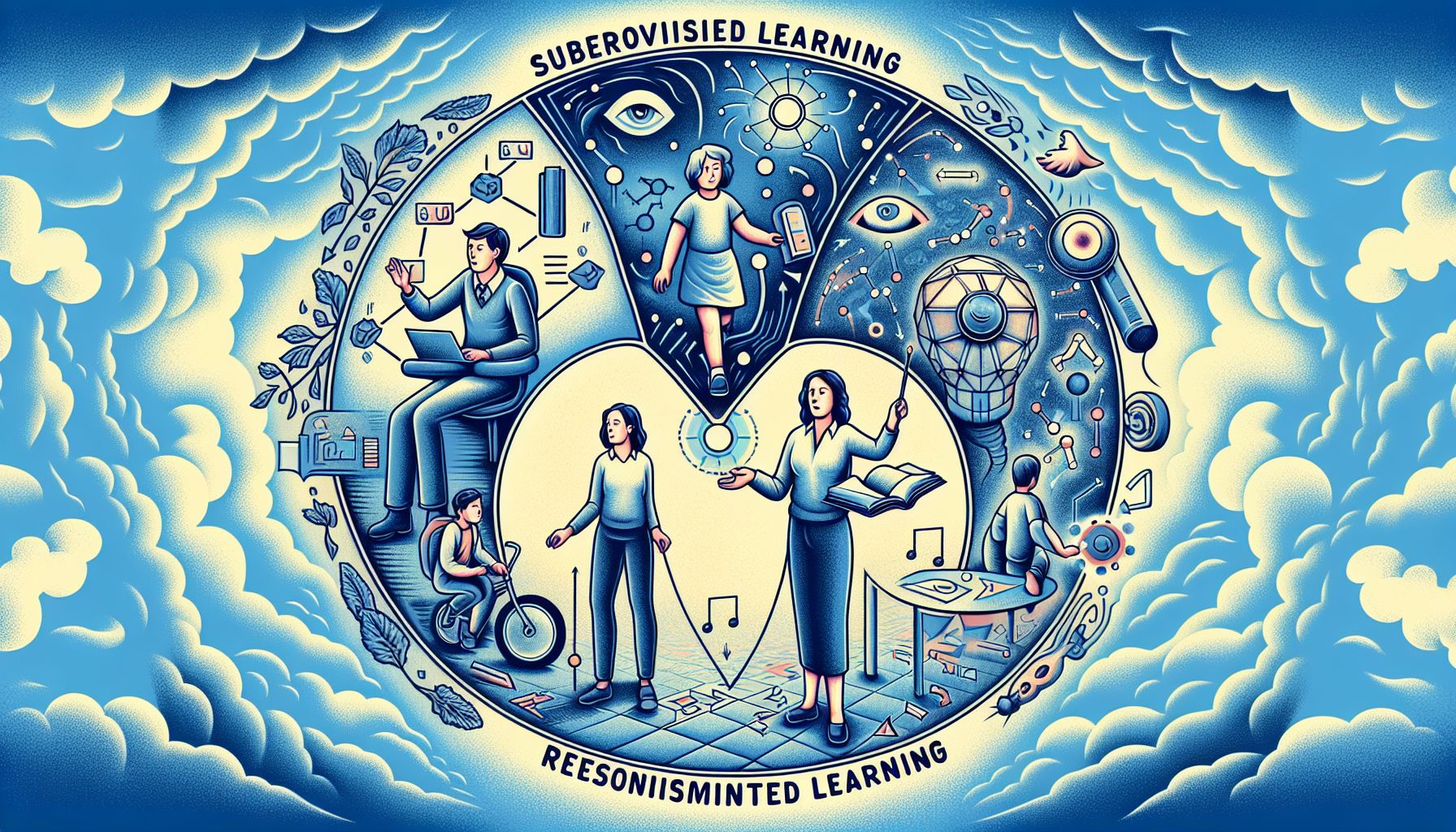⚡ “Imagine having a GPS that not only guides you, but also learns from your driving habits! Dive into the world where artificial intelligence isn’t just fed data but nurtures its ability to learn, explore, and improve!”
Welcome to the fascinating world of Machine Learning! If you’re reading this, you’ve probably heard of the terms Supervised Learning, Unsupervised Learning, and Reinforcement Learning. As for These, they’re the primary types of learning in the Machine Learning universe. But what do they mean, and how do they differ? If you’re scratching your head trying to figure this out, don’t worry, you’re not alone 🧐. Through this blog post, we take a deep dive into the world of these learning models. By the end of this journey, you’ll not only distinguish between these three learning types, but you’ll also know when to apply each of them. So, buckle up! Let’s start this exciting journey into the core of Machine Learning.
🎯 Supervised Learning: The Guided Tour

"Three Learning Paths: Supervised, Unsupervised & Reinforcement"
You must have heard the saying, ‘Every journey begins with a single step’. In machine learning, that first step is often Supervised Learning. If you’re new to the field, this is where you’ll likely start. Supervised Learning is much like learning under the guidance of a tutor. Imagine you’re learning to paint. A teacher guides you, providing a picture to replicate and offering feedback on your attempts. This real-world analogy is precisely how Supervised Learning works! In Supervised Learning, you have a dataset that consists of both input variables (features) and an output variable (label or target). The goal is to create a model that can map inputs to outputs accurately, just like you would map brush strokes to create a beautiful painting 🎨.
How Does it Work?
- Training: The model is exposed to a training set, which includes both input data and the corresponding correct answers (labels). The model makes predictions based on the input data, and errors are corrected during training.
- Testing: The model is tested with a separate dataset to evaluate its performance. If it can accurately predict the output of the test data, we say it has ‘learned’ from the training process. Some popular algorithms used in Supervised Learning include linear regression, logistic regression, decision trees, and support vector machines (SVM).
When to Use Supervised Learning?
Supervised Learning is the go-to option when you have labeled data, i.e., when the output results are known. In fact, best suited for problems where prediction is the primary goal. For example, predicting house prices, classifying emails as spam or not spam, or diagnosing diseases.
🕵️ Unsupervised Learning: The Explorer
Unsupervised Learning is like being an explorer in an unknown land. Here, you’re not given any directions. You have to observe your surroundings, recognize patterns, and make sense of it all by yourself. It’s all about discovery! In Unsupervised Learning, we only have input data (features), and no corresponding output variables. The model works on its own to discover information. It usually deals with finding a structure or pattern, like grouping customers by purchasing behavior.
How Does it Work?
- Clustering: The model groups the data into several clusters based on similarity. Each cluster of data would have similar traits. It’s like grouping apples and oranges based on their color or taste.
- Association: The model identifies rules that describe large portions of the data, like customers who buy bread also tend to buy butter. Some popular algorithms used in Unsupervised Learning include K-means, Hierarchical Clustering, and Apriori algorithm.
When to Use Unsupervised Learning?
Unsupervised Learning is best when you have unlabeled data. It’s also excellent for exploratory analysis, where you don’t have a specific target variable. For example, segmenting the customer base into different groups for targeted marketing or finding associations between products for recommendation systems.
🎮 Reinforcement Learning: The Game Player
Imagine playing a video game. You start off knowing nothing about the game. As you play more, you learn from your mistakes and successes, gradually improving your performance. That’s precisely how Reinforcement Learning works! In Reinforcement Learning, an agent learns to behave in an environment, by performing actions and seeing the results. The agent learns from the consequences of its actions, rather than from being explicitly taught. It’s all about learning from trial and error.
How Does it Work?
- Agent: Interestingly, the model or the learner. It makes decisions.
- Environment: Interestingly, everything the agent interacts with.
- Actions: As for These, they’re what the agent can do.
- Rewards: As for These, they’re feedback signals. Positive rewards encourage the agent to continue the behavior, while negative rewards discourage it.
- Policy: Interestingly, the strategy that the agent employs to determine the next action based on the current state. Some popular algorithms used in Reinforcement Learning include Q-Learning, Deep Q Network (DQN), and Proximal Policy Optimization (PPO).
When to Use Reinforcement Learning?
Reinforcement Learning is excellent for problems where decision-making is sequential, and the goal is long-term, such as game playing, robotics, navigation, or stock trading.
🧭 Conclusion
By now, you should have a clear understanding of the difference between Supervised, Unsupervised, and Reinforcement learning. Remember, Supervised Learning is the guided tour, where you learn under supervision. Unsupervised Learning is the explorer, where you discover and learn on your own. Lastly, Reinforcement Learning is the game player, where you learn from your experiences. Choosing the right learning model depends on your dataset and the problem you’re trying to solve. Sometimes, you might even need to combine these learning types. So, keep exploring and learning. After all, the world of Machine Learning is as exciting as it is vast. Happy Learning! 🚀
The future is unfolding — don’t miss what’s next! 📡
🔗 Related Articles
- Difference Between Supervised and Unsupervised Learning
- Introduction to Supervised Learning ?What is supervised learning?Difference between supervised and unsupervised learning, Types: Classification vs Regression,Real-world examples
- “Exploring Virtual Reality: The Future of Online Learning and Gaming”
